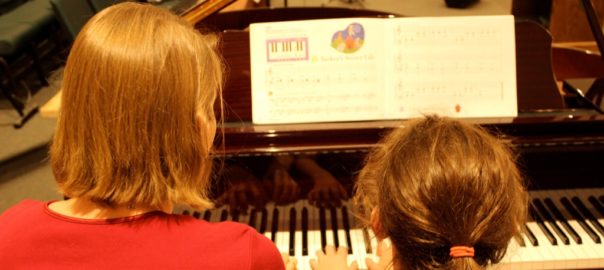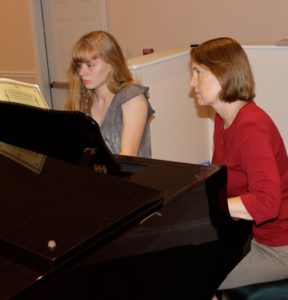When beginning piano lessons, a big factor will be the piano you choose. Some students already have pianos in their homes. However, many do not. Many parents have asked me for advice on choosing an instrument through the years, so here are some guidelines.
Guidelines for Choosing an Acoustic Piano
First of all,
when choosing a piano, please don’t get a
piano without taking a tuner with you to inspect it first. Even a “free”
piano is never free because the work it may take the tuner to get and keep it playable may cost a lot in the long run. My son,
Bill, who is a piano tuner trained at North Bennet Street School, offers appraisals to ensure you choose a good instrument and avoid “lemons.”
Secondly, Bill says to stay away from
spinet pianos if at all possible. The tuners charge more to service them because it is difficult to access the knobs.
To choose a piano that is not a spinet, the measurement from floor to top of
piano should be at least 40 inches.
Thirdly, when
choosing a piano, remember that it takes at least 4 strong men, blankets for protection, straps for securing, and a truck (preferably with a trailer) with extra suspension to move it. I recommend a
moving service.
Fourthly, to keep a
piano well, it needs to be tuned at least annually. Obviously, my recommendation is
Bill. 🙂
Finally, to keep a piano in good condition, it needs to be where you are, meaning temperature-controlled and against an inside wall. That also means if someone posts a picture of the “free” piano, and it appears to be in a basement or garage, don’t even look at it.
Guidelines for Choosing a Digital Piano
- Weighted keys
- 88 key-keyboard
- Damper pedal
- Bench
- Stand (sometimes they are built into cabinets, sometimes the stand comes separately)
A keyboard with weighted keys is best if you decide to
choose a piano that is digital or electronic. Determine if mobility is important for your instrument because some digital keyboards are portable, being sold separately from their stands and seats, and some come encased. Though not heavy like an acoustic piano, these digital keyboards are less portable. Another factor is stability. Some keyboards, while very light and portable, do not withstand the heavy playing of intermediate and advanced students.
The other consideration is full 88 keys or a smaller model. I recommend a full 88 key keyboard even for beginners.
Pros and Cons of Acoustic Versus Digital Pianos
Pros and cons of acoustic versus digital keyboards must be weighed here. First of all, there is nothing as wonderful as the feeling of the vibrations of real strings as a pianist plays. However, there is nothing so dreadful as the terrible sound coming from a badly kept, out of tune piano. Pros: Good vibrations, stable to withstand heavy playing, aesthetic beauty.
Cons: Annual maintenance & repairs, depending on needs begins at about $150, lack of portability, requires space in temperature-controlled environment.
That being said, advantages to digital keyboards would include headphone and computer interface capability, and, as stated earlier, mobility. The obvious disadvantage would be digitized sound rather than the percussive sound from the hammers striking the strings, and perhaps the lack of stability (in some models) that is needed for intermediate to advanced players.
Pros: No maintenance (unless digital parts wear out–this is a possibility in older keyboards and those played by advanced students), headphone jacks, computer capabilities, portability. Cons: No aesthetic qualities, lack of acoustic vibrations, lack of stability. The Piano Technicians Guild offers
this handy guide for deciding between acoustic and digital pianos.
Each family should consider all the options when
choosing a piano.
The Piano Technician’s Guild has a more detailed guide you could also use. If you have any questions, please don’t hesitate to
ask!

